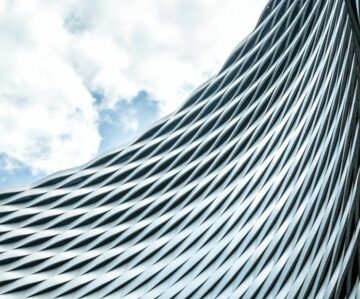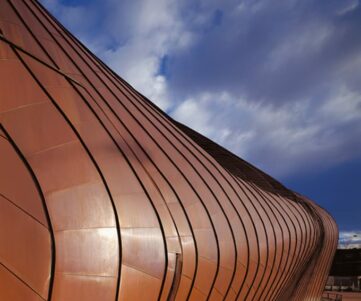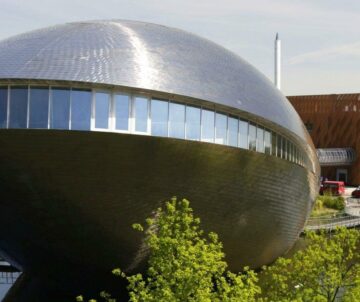INTRODUCTION
A proper sheet metal roofing or metal panels may have a higher initial cost. But in the long run, it ensures lower energy consumption, good weatherproofing, no pain-staking headaches of leaking issues, low maintenance, and it will avoid future costly re-roofing jobs.
Issues | Common Myths & Perceptions | Solutions |
|---|---|---|
Rusts | Being "metal" | Use of non-ferrous materials |
Noisy | Because of its thin metal surface | Full substrate support |
Hot | Metal transfers heat easily | Adequate maintenance-free and multi-layered insulation |
Ugly Factory-Look | Close corrugation, large side edges and deep ribs | Wide pan, thin straight edges and low seam height |
Attracts Lightning | Metal roof attracts lightning | Lightning strike the nearest (highest) object, be it a metal or wood |
Use of non-ferrous metals like aluminium ensures these metal roofing lasts a lifetime and will be totally recyclable in the future. ALCOM offers buy back guarantee of their aluminium at the end of building life.
This section is about the introduction to various materials offered and choosing the right material to be used.
It is also about making that quantitative versus qualitative decision or should it be a rational versus emotional decision. Ultimately, it is what you desire that counts.
Technical and Economic Aspect
Cost, life cycle costing, ease of maintenance, cleaning and servicing. Low pitched. Resistance to external factors.
Heritage Aspect
Heritage conservation orsimply, Creating a legacy.
Design Structuring Aspect
Blending into its surroundings or be visually outstanding.

Aluminium
Light-weight, economical and attractive material to be used in architectural application. Mill-finished Aluminium itself is very durable. If PVDF coated, the polyvinylidene difluoride coating will not fade or peel-off over a long period of time. Architects or owners can choose from virtually unlimited range of colour to meet their intended colour scheme.

Titanium
The eternity material, is the noblest architectural metal used for roofing and wall cladding. The outstanding durability, corrosion resistance and strength enable Titanium to outperform any other material. Once installed, the Titanium roof and Titanium façade will last forever. The designer does not have to worry about the design life of the building envelop because Titanium stands against through-wall corrosion for hundred years with their warranty.

Copper
Known to be a versatile material, is used in various industries including electronics, electrical engineering, refrigeration, heating system, etc. Due to its superior mechanical and physical properties, copper is used in roofing and plumbing industries as well. As a timeless material, copper enhances the appearance of the building.Copper oxidised over time. From bright copper surface factory finished, it develops a dark brown oxide layer within just a few months. Later, over a period of 10-20 years, this oxide layer turns green to form a stable copper patina.Copper also has a self-healing and self-cleaning surface, naturally, also known as patina. The light green colour of the copper patina is an attractive feature of aged copper. Since it is formed organically, the colour will not fade or peel off anymore. The copper patina forms a protective layer over the entire surface that will last for ages.

Stainless Steel
It’s appearance, strength and high corrosion resistance makes it an ideal material to be used in as a building envelop, especially those in coastal areas. Stainless Steel has a subtle sheen surface which does not overwhelm or intrude other design and colour element. Its’ surface, if unpainted, also self-heals from minor mechanical and chemical damage by formation of an invisible protective film of chromium-rich oxide. Depending on the application environment, 2 common grades are available: Grade 304 and Grade 316.

Titanium Zinc
The warm, pleasant looks of the weathered Titanium Zinc makes this material popular in architectural application. Mill-finished Titanium Zinc develops a natural blue-grey patina on the surface after exposure to weather for a period of time. This protective layer ‘heals’ itself if the surface is damaged and protects the core material from further corrosion (thus called ‘living material’).

Pre-painted Steel
The last resort for premium metal roof and cladding when the budget constraint does not permit the use of all other materials above.This material is, in actual fact, not recommended for premium roofing and cladding system due to its property. Even with the best metallic coating, the life-span of steel is relatively shorter compared to other materials listed above.The steel core relies solely on the coatings for protection. Usually this system requires a lot of bending and hand-crafting. This forming process will scratch or damage the surface coating of the material. Once the steel core is exposed, it starts to rust. The corrosion will then spread throughout the entire roof or façade.

